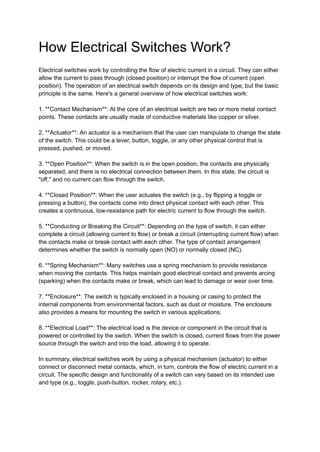How Electrical Switches Work?
How Electrical Switches Work? Electrical switches work by controlling the flow of electric current in a circuit. They can either allow the current to pass through (closed position) or interrupt the flow of current (open position). The operation of an electrical switch depends on its design and type, but the basic principle is the same. Here's a general overview of how electrical switches work: 1. **Contact Mechanism**: At the core of an electrical switch are two or more metal contact points. These contacts are usually made of conductive materials like copper or silver. 2. **Actuator**: An actuator is a mechanism that the user can manipulate to change the state of the switch. This could be a lever, button, toggle, or any other physical control that is pressed, pushed, or moved.

Recommended
Recommended
More Related Content
Similar to How Electrical Switches Work?
Similar to How Electrical Switches Work? (20)
Recently uploaded
Recently uploaded (20)
How Electrical Switches Work?
- 1. How Electrical Switches Work? Electrical switches work by controlling the flow of electric current in a circuit. They can either allow the current to pass through (closed position) or interrupt the flow of current (open position). The operation of an electrical switch depends on its design and type, but the basic principle is the same. Here's a general overview of how electrical switches work: 1. **Contact Mechanism**: At the core of an electrical switch are two or more metal contact points. These contacts are usually made of conductive materials like copper or silver. 2. **Actuator**: An actuator is a mechanism that the user can manipulate to change the state of the switch. This could be a lever, button, toggle, or any other physical control that is pressed, pushed, or moved. 3. **Open Position**: When the switch is in the open position, the contacts are physically separated, and there is no electrical connection between them. In this state, the circuit is "off," and no current can flow through the switch. 4. **Closed Position**: When the user actuates the switch (e.g., by flipping a toggle or pressing a button), the contacts come into direct physical contact with each other. This creates a continuous, low-resistance path for electric current to flow through the switch. 5. **Conducting or Breaking the Circuit**: Depending on the type of switch, it can either complete a circuit (allowing current to flow) or break a circuit (interrupting current flow) when the contacts make or break contact with each other. The type of contact arrangement determines whether the switch is normally open (NO) or normally closed (NC). 6. **Spring Mechanism**: Many switches use a spring mechanism to provide resistance when moving the contacts. This helps maintain good electrical contact and prevents arcing (sparking) when the contacts make or break, which can lead to damage or wear over time. 7. **Enclosure**: The switch is typically enclosed in a housing or casing to protect the internal components from environmental factors, such as dust or moisture. The enclosure also provides a means for mounting the switch in various applications. 8. **Electrical Load**: The electrical load is the device or component in the circuit that is powered or controlled by the switch. When the switch is closed, current flows from the power source through the switch and into the load, allowing it to operate. In summary, electrical switches work by using a physical mechanism (actuator) to either connect or disconnect metal contacts, which, in turn, controls the flow of electric current in a circuit. The specific design and functionality of a switch can vary based on its intended use and type (e.g., toggle, push-button, rocker, rotary, etc.).